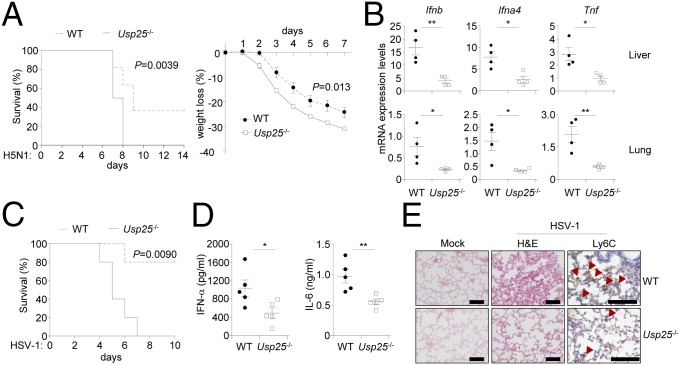Fig. 3.
USP25-deficient mice are more susceptible to the infection with H5N1 and HSV-1. (A) Usp25−/− mice exhibited earlier mortality and more severe weight loss after H5N1 infection than did wild-type mice. Wild-type (n = 10) and Usp25−/− mice (n = 11) were infected with the H5N1 influenza virus (1 × 103 EID50 per mouse) and the survival and weight loss were monitored every day. (B) The expression of Ifnb, Ifna4, and Tnf was inhibited in the lungs and livers of Usp25−/− mice after H1N1(PR8) virus challenge compared with the wild-type mice. Mice (n = 4) were infected with H1N1(PR8) and lungs and livers were collected for qPCR analysis 24 h after infection. (C and D) Usp25−/− mice exhibited higher mortality rate and produced decreased amount of IFN-α and IL-6 cytokines after HSV-1 challenge than did the wild-type mice. Wild-type and Usp25−/− mice (n = 5) were infected with HSV-1 (1 × 106 pfu). The survival of mice was monitored every day (C). The sera were collected at 12 h after infection followed by ELISA analysis (D). (E) Usp25−/− mice showed less Ly6C+ monocytes infiltration in the lungs than did wild-type mice. Wild-type and Usp25−/− mice (n = 3) were infected with HSV-1 (2 × 106 pfu). Twenty-four hours after infection, lungs from mice were isolated and subject to histological analysis. [Original magnification, × 20 (H&E) or ×40 (Ly6C).] (Scale bars, 100 μm.) Arrow heads, infiltrated Ly6C+ monocytes. Data are representative of two independent experiments. *P < 0.05, **P < 0.01.

